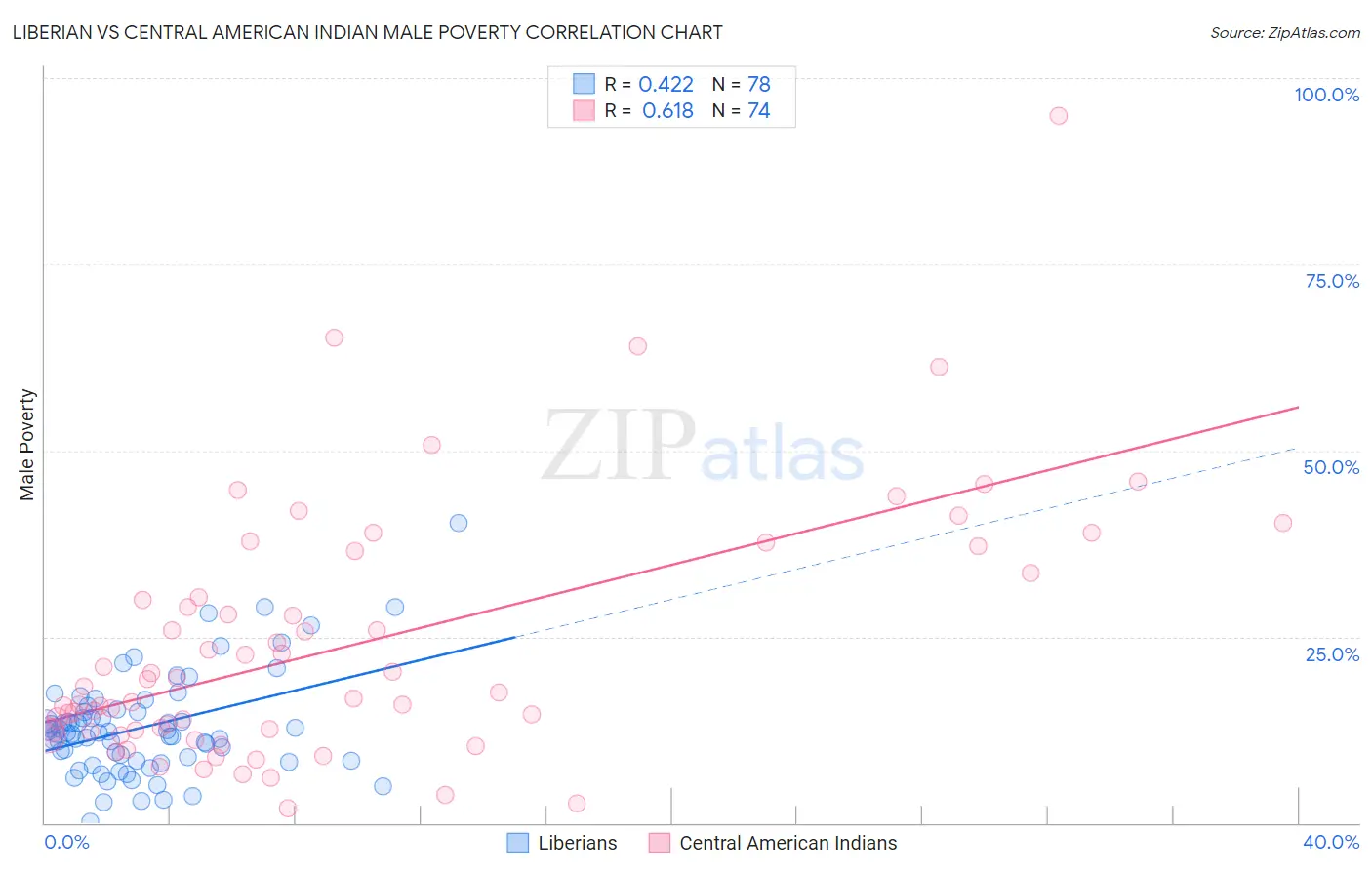Liberian vs Central American Indian Male Poverty
COMPARE
Liberian
Central American Indian
Male Poverty
Male Poverty Comparison
Liberians
Central American Indians
12.8%
MALE POVERTY
0.3/ 100
METRIC RATING
245th/ 347
METRIC RANK
15.3%
MALE POVERTY
0.0/ 100
METRIC RATING
326th/ 347
METRIC RANK
Liberian vs Central American Indian Male Poverty Correlation Chart
The statistical analysis conducted on geographies consisting of 118,033,924 people shows a moderate positive correlation between the proportion of Liberians and poverty level among males in the United States with a correlation coefficient (R) of 0.422 and weighted average of 12.8%. Similarly, the statistical analysis conducted on geographies consisting of 326,052,023 people shows a significant positive correlation between the proportion of Central American Indians and poverty level among males in the United States with a correlation coefficient (R) of 0.618 and weighted average of 15.3%, a difference of 19.6%.

Male Poverty Correlation Summary
| Measurement | Liberian | Central American Indian |
| Minimum | 0.17% | 1.9% |
| Maximum | 40.3% | 94.9% |
| Range | 40.1% | 93.0% |
| Mean | 12.9% | 23.8% |
| Median | 12.1% | 17.9% |
| Interquartile 25% (IQ1) | 8.4% | 12.5% |
| Interquartile 75% (IQ3) | 15.0% | 33.5% |
| Interquartile Range (IQR) | 6.6% | 21.1% |
| Standard Deviation (Sample) | 6.8% | 16.9% |
| Standard Deviation (Population) | 6.8% | 16.8% |
Similar Demographics by Male Poverty
Demographics Similar to Liberians by Male Poverty
In terms of male poverty, the demographic groups most similar to Liberians are Tsimshian (12.8%, a difference of 0.010%), Alaskan Athabascan (12.8%, a difference of 0.12%), Nepalese (12.8%, a difference of 0.16%), Immigrants from El Salvador (12.8%, a difference of 0.30%), and Sudanese (12.8%, a difference of 0.32%).
| Demographics | Rating | Rank | Male Poverty |
| Ecuadorians | 0.4 /100 | #238 | Tragic 12.7% |
| Ghanaians | 0.4 /100 | #239 | Tragic 12.7% |
| Immigrants | Middle Africa | 0.4 /100 | #240 | Tragic 12.7% |
| Sudanese | 0.3 /100 | #241 | Tragic 12.8% |
| Nepalese | 0.3 /100 | #242 | Tragic 12.8% |
| Alaskan Athabascans | 0.3 /100 | #243 | Tragic 12.8% |
| Tsimshian | 0.3 /100 | #244 | Tragic 12.8% |
| Liberians | 0.3 /100 | #245 | Tragic 12.8% |
| Immigrants | El Salvador | 0.2 /100 | #246 | Tragic 12.8% |
| Immigrants | Western Africa | 0.2 /100 | #247 | Tragic 12.9% |
| Immigrants | Sudan | 0.2 /100 | #248 | Tragic 12.9% |
| Potawatomi | 0.2 /100 | #249 | Tragic 12.9% |
| Immigrants | Nicaragua | 0.2 /100 | #250 | Tragic 12.9% |
| Immigrants | Cuba | 0.2 /100 | #251 | Tragic 12.9% |
| Immigrants | Ecuador | 0.2 /100 | #252 | Tragic 12.9% |
Demographics Similar to Central American Indians by Male Poverty
In terms of male poverty, the demographic groups most similar to Central American Indians are Yakama (15.3%, a difference of 0.11%), Menominee (15.3%, a difference of 0.29%), Colville (15.2%, a difference of 0.48%), Kiowa (15.2%, a difference of 0.87%), and Arapaho (15.1%, a difference of 1.6%).
| Demographics | Rating | Rank | Male Poverty |
| U.S. Virgin Islanders | 0.0 /100 | #319 | Tragic 14.7% |
| Immigrants | Congo | 0.0 /100 | #320 | Tragic 14.7% |
| Arapaho | 0.0 /100 | #321 | Tragic 15.1% |
| Kiowa | 0.0 /100 | #322 | Tragic 15.2% |
| Colville | 0.0 /100 | #323 | Tragic 15.2% |
| Menominee | 0.0 /100 | #324 | Tragic 15.3% |
| Yakama | 0.0 /100 | #325 | Tragic 15.3% |
| Central American Indians | 0.0 /100 | #326 | Tragic 15.3% |
| Paiute | 0.0 /100 | #327 | Tragic 15.8% |
| Blacks/African Americans | 0.0 /100 | #328 | Tragic 15.8% |
| Dominicans | 0.0 /100 | #329 | Tragic 16.1% |
| Immigrants | Dominican Republic | 0.0 /100 | #330 | Tragic 16.2% |
| Ute | 0.0 /100 | #331 | Tragic 16.2% |
| Houma | 0.0 /100 | #332 | Tragic 16.7% |
| Natives/Alaskans | 0.0 /100 | #333 | Tragic 16.9% |